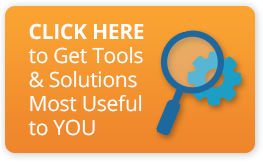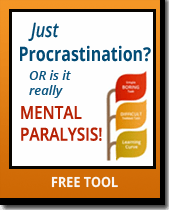When you’re overwhelmed to start, and afraid to finish
I am most accustomed to having clients say that they have trouble getting started on a necessary task until the deadline for completion is almost upon them.Then, as if by magic, they are suddenly able to focus and concentrate on doing the work.Of course, this is simply their adrenaline kicking in: the neurotransmitter chemical in their brains that allows them to focus.Adrenaline kicks in when people are in a situation of fear, excitement, anxiety or stress.
But adrenaline doesn’t work the same way in everybody with ADD / ADHD.I recently started work with a client, Alex, whose brain shut down when faced with a deadline.He typically would feel calm about assignments when they weren’t due for several weeks.But the closer the deadline came, the LESS likely he was to be able to focus on the task.Instead, he became distracted by the negative “chatter” in his head:fear of failure, and negative ruminating on “what’s the use” destroyed his ability to focus on the work.
The challenge here was twofold.First, Alex needed to learn how to begin his project well in advance of the deadline.
Second, he needed strategies to pull out of negative rumination and paralysis when he was close to deadline.
What kept Alex from beginning sooner? There could be a number of reasons.
Why Didn’t Alex Begin Sooner?
A common reason many people with ADD don’t begin their projects sooner is inertia, coupled with the belief that they have plenty of time.In Alex’s case, his initial feeling of calmness about the project was misleading.When faced with actually having to work on the project, he would immediately feel overwhelmed and not know how to start.So the strategy for Alex to put off procrastinating would be to give him tools on HOW to start.
Starting with a blank piece of paper, I showed Alex how to MIND-MAP the different stages and action steps involved in his project.We began by him visualizing beginning any place at all, at random.If he would be unable to actually begin at that step because something else would have had to be done first, then he’d imagine starting at that earlier stage.Working backwards in his mind, eventually Alex would arrive at the real starting point of the project.Meanwhile, he was writing down each step on the mind map.
Mind maps are great for getting your random thoughts down, but they tend to end up looking messy.So once the mind map seemed fairly complete, it was time to transfer these written steps to a more logical format that anyone could follow.
I helped Alex design a PROJECT STATUS template that he could pull up and use for any project.It was a form that he could use to fill in the steps of the project.The form had columns for PROJECT STEPS, WHO INVOLVED, TARGET DATE, STATUS, and COMMENTS.This would serve several purposes:
- It allowed Alex to fill in what he already knew, an easy way to “flow” into the project.
- He could email this template to his boss and anyone else involved in the project to communicate project status and updates without having to compose wordy descriptions (great for those who don’t like to write!).
- It would help Alex stay on track with various steps and deadlines, and would allow him to talk about his progress at a moment’s notice.
A Project Status Form is only useful if it is updated on a regular basis. That's where it became important for Alex to create a “Ritual” of performing regular updates.





How to Consistently Do Boring Maintenance Tasks | ThriveWithADD Blog
[…] to content ← Project Paralysis on Both Ends: an ADHD Dilemma ADHD Creativity: Too Much of a Good Thing? […]